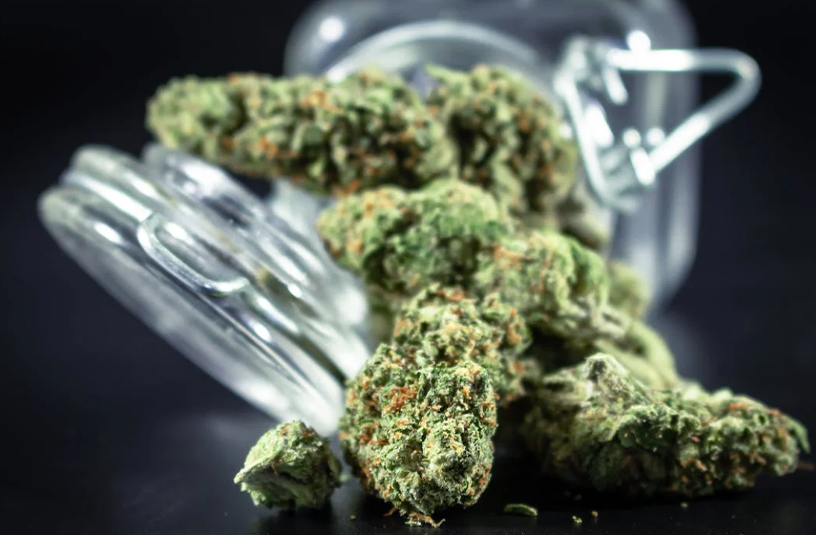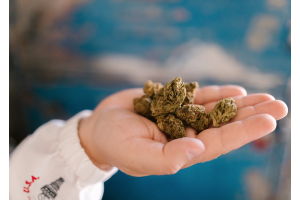The Emperor Is Still Naked: Why The Term 'Medical Cannabis' Is Incorrect

The late great Jack Herer's magnum opus 'The Emperor wears no clothes' revealed the naked truth about cannabis and the history of its prohibition.
It sought to expose the lies and myths that have severed our connection to our oldest companion species and reconnect us with the power and majesty of the cannabis plant.
In writing this article, I seek to follow in the footsteps of one of my heroes and the forefathers of our movement. This great work achieved many things and is still regarded as the premier text for cannabis advocates and activists. I hope to convince you that despite all the knowledge, inspiration, and passion his seminal tome has passed down to generations of activists, the Emperor is still naked.
In the original Hans Christian Andersen classic fairytale that inspired the title of Jack's book, two traveling swindlers arrive in the capital of a distant wealthy land. The men let it be known that they are weavers of"the most magnificent fabrics imaginable."Upon hearing of the two traveling weavers and their magnificent wears, the ruler of this land, a vain and self-obsessed Emperor known to be more commonly found in his wardrobe than his throne room, demanded an audience.
Upon meeting the Emperor, the weavers convinced the conceited and egoistical ruler that"Not only were their colors and patterns uncommonly fine, but clothes made of this cloth had a wonderful way of becoming invisible to anyone unfit for his office, or who was unusually stupid."1The Emperor paid the weavers a large sum as he remained transfixed by the potential power the mystical garm held to separate the wise from the fool and root out those unfit for their post. Believing the conmen to be truthful, the weavers were given the land's finest silks and purest old threads to produce the fanciful wardrobe.
The capital and its ruler grew impatient with the weaver's long nights at the loom. They couldn't wait to see who amongst them was unfit and who was the fool. Racked with growing self-doubt about his worthiness to rule, the Emperor decided to send his honest old minister to see how production was going.
The minister arrived to find the weavers working on empty looms. Surprised and fearing his stupidity or unfitness for his role, the older man said nothing. The tricksters begged the man to inspect the intricacies of their wear. Asking his opinion on the produce, he could not see the old minister replied,"Such a pattern, what colors! I'll tell the Emperor how delighted I am with it."1Pleased with their entrapment of the foolish old minister, the weavers explained the intricate patterns and named all the colors the clothing possessed. They then asked for more money, silk, and fine thread to continue working on the mythical garments. With the increased materials and funds, the weavers worked harder than ever, pretending to weave while pocketing the land's riches.
A while later, another trusted advisor was sent to check on progress, and the events repeated exactly as before. When the Emperor eventually went to see the weavers with his two advisors, he saw nothing but weavers working empty looms. Suspicious of his unfitness to rule and stupidity but too ashamed to reveal it, the Emperor awarded each of the men a cross and the title of sir weaver.
The Emperor arranged a procession through the capital to show off the anticipated attire. On a special day, the two now relatively rich conmen helped the Emperor from his old physical clothes and into the new imaginary ones they had convinced others could see
The entire city goes along with the charade complementing the Emperor's finery and splendor until one young boy exclaims,"but he hasn't got anything on."At first, the boy's father tries to excuse his innocent son, but quickly the utterance reverberates through the crowd until everyone cries,"but he hasn't got anything on."The Emperor's suspicions were confirmed but unperturbed as"this procession has got to go on. So he walked more proudly than ever, as his noblemen held high the train that wasn't there at all." 1Now, why have I just recounted this centuries-old fable? Is it because I have an affinity for Nordic fairy tales? Well, no, regardless of how interesting their folklore may be. It is because I feel this story is the perfect metaphor to describe what is currently happening within the global cannabis industry, particularly in the UK.
Just think about it for a second. The two traveling swindlers are a stand-in for the neo-liberal capitalist investors, their cabal of commercial conspirators, and lobbyists currently traversing the world, prying and probing for quick return investment opportunities in emerging cannabis markets.
They arrive in a new land and con the Emperor, a substitute for the out-of-touch governments of various countries around the world, into believing that they alone possess the ability to produce these delicate garments (limited 'medical access' model). They trick the governments into turning their backs on the excising industry weavers and loomers (legacy industry growers and dealers) through their well-rehearsed slick advertising, lobbying, and marketing gimmicks and tricks.
Their con complete, the Emperor (government) gleefully parades their clothing (limited 'medical access' model) to the cheering townsfolk, a stand-in for the general non-consuming population of any nation. It isn't until a young boy (the cannabis-consuming community) points out the falsehoods, fragility, and fictitious nature of the emperors (governments) clothes (model) that the public feels safe to join in the rebuke and ridicule of the capitalist pageantry being performed before them.
The quintessential pseudo term and gimmick used by these charlatan weavers to trick the Emperor are 'Medical Cannabis.' A term that, in truth, is little more than a Search Engine Optimised (SEO) and marketing term. By using this faux advertising term, businesses can protect themselves from association and exposure to the controversial legacy of cannabis prohibition and the millions of potentially criminalized consumers.
Those same individuals use 'Medical Cannabis' to create and engineer spaces for private enterprises to profiteer from the continued exploitation of infirm, unwell, and vulnerable, unwell individuals.Still don't believe me that there is a con going on here? Let's look at the language this cabal uses to further their interests.The use of unscientific and contradictory terms is, in my opinion, intentional. It is used to stifle debate, obscure research, and data, and perpetuate cannabis prohibition, not end it. If their claims of'being in it for the patient'were true, then you would hope the science and nomenclature being
used would be accurate and factual. Unfortunately, this just isn't the case.'Medical Cannabis' is an inaccurate term because of the definition of the word medical. Which is defined by Oxford Languages as'relating to the science or practice of medicine.'Medicine is defined as'the science or practice of diagnosing, treating, and preventing disease.'Making'the medicinal use of'is the clearest and most accurate way to define it in English. Whereas'medicinal'is defined as '(of a substance or plant) having healing properties.'A phraseology is generally regarded as the correct one when referring to the consumption of cannabis for health reasons.Think of it this way if you got a nettle sting, you wouldn't use a medical dock leaf; you would medicinally use a dock leaf to treat the sting medically. In both instances, it is a plant, not a medical device or manufactured drug, so describing it as medical would be inaccurate.
Reading this, you might wonder why I care so much about using a single word. Well, it's because I believe it is emblematic of a far larger problem pervading society, the erasure of the public's awareness and knowledge of the healing properties of the natural world. This loss of our connection to nature has caused an overreliance on modern pharmacopeia and an explosion in illness and disease.
The deliberate misuse of 'medical' over 'medicinal' concerning cannabis is, in my opinion, an attempt to further erode the public's awareness of the cannabis plant as a powerful holistic and therapeutic tool. It implies that 'normal' cannabis cannot be used medicinally. That cannabis is only medicines when we all know it to be the single most versatile natural resource humankind has ever known.
This is no more evident to me than in the UK government's definition of 'Medical Cannabis'as a "Cannabis-Based Product for Medicinal Use in Humans"or 'CBPM'2. So what is a CBPM? That is defined under Schedule 2 of the Misuse of Drugs Regulations 2001 amendment 2018 as"a preparation or other product which is or contains cannabis, cannabis resin, cannabinol or a cannabinol derivative. Is produced for medicinal use in humans and is a medicinal product or a substance or preparation for use as an ingredient of, or in the production of an ingredient of, a medicinal product.
"So all cannabis is a 'CBPM'or'medical cannabis'?But it's only lawful to access and consume it in the UK when an inexperienced bureaucratically authorized individual prescribes it? Millions of UK residents are unlawfully consuming cannabis, whether medicinally or otherwise, and facing criminalization under schedule 1 of the Misuse of Drugs Act 1971. That sounds a lot like social engineering, racketeering, and profiteering predicated on exploiting the nuance of language to me
Written and Published by Simpa in Weed World Magazine Issue 159
Featured Image: Pexels












Validate your login